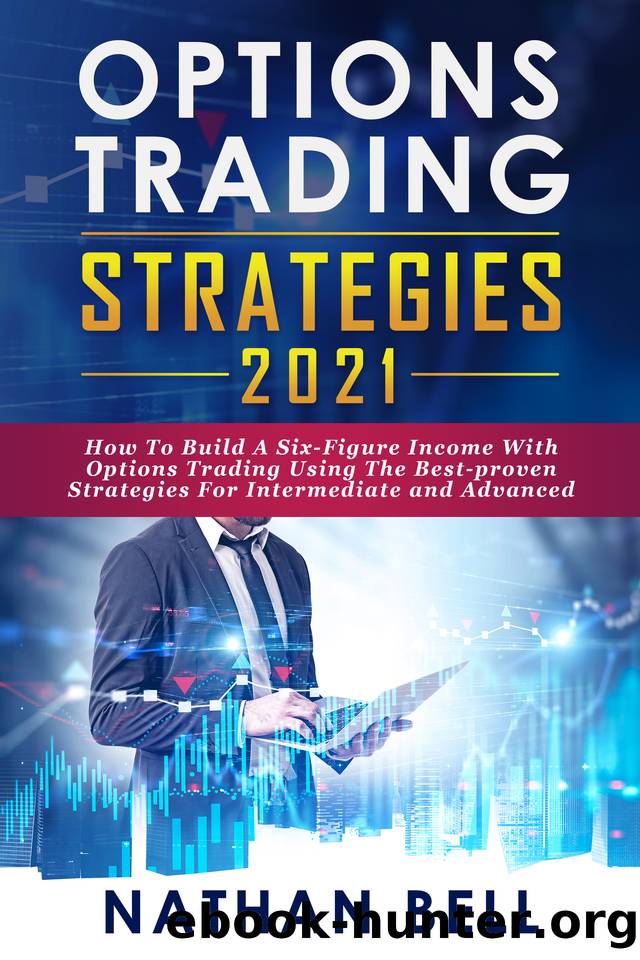OPTIONS TRADING STRATEGIES 2021: How To Build A Six-Figure Income With Options Trading Using The Best-proven Strategies For Intermediate and Advanced by Bell Nathan

Author:Bell, Nathan [Bell, Nathan]
Language: eng
Format: epub
Published: 2020-10-03T00:00:00+00:00
So, for example, if we are using a oneâ year time frame and the highest the implied volatility has been is 40, the lowest it has been is 20, and the current implied volatility is 25, the stocks IV percentile would be as follows:
(25 â 20) / (40 â 20) = 5/20 = .25, or 25th percentile
Some traders will mistakenly call this metric âIV Percentile.â Mathematically, that is incorrect, and I will call this âIV Range.â Although this calculation makes intuitive sense, it does not always reflect wherein its normal range the current implied volatility currently resides (and is, in fact, a ratio and not a percentile). To illustrate this, letâs assume that the underlying represented earlier trades typically in the 20 to 25 IV range. Letâs assume that in the past one year, or 252 trading days, the implied volatility for the underlying exceeded25 in only one day. On this day, the implied volatility stood at 40 due to some unusual event. If today the implied volatility of this underlying stands at 25, the other calculation shows it to be in its 25th percentile. Yet it surely is trading at a reasonably costly implied volatility for the underlying as on all, but one day the implied volatility was less than or equal to its current reading. And this defines the second means of calculating the implied volatility percentile. Again assuming we are using one year, we can take the current implied volatility and determine how many days the implied volatility has exceeded or been beneath the current reading. Using this calculation, our implied volatility percentile for the other stock would be 99 percent or 100 percent, as the 25 percent IV was exceeded only once in the past year out of 252 reading days. While these two calculations do not always show such a dramatic difference, it is essential to take note of the strengths and weaknesses of each, as some software packages you will encounter may use one or the other of the calculations.
So how do we use this number in our trading? It would seem logical that if the underlying was trading at more magnificent than its 50th percentile, we might be interested in selling premium. And if the underlying was trading at less than its50th percentile, we might be interested in buying premium. After all, if we believe that implied volatility is mean reverting, doesnât that mean we believe the implied volatility will trend back toward its 50th percentile? In practicality, it is not that simple for three reasons.
First, as we have discussed, our option trades have a limited life span. So though I believe in mean reversion for implied volatility, It shouldnât be assumed that an option will complete its mean reversion before the optionâs expiration.
Secondly, when the market gets quiet and realized volatility slows, most underlying will fall to below their 50th percentile. It is often the case that during those times, the selling option premium gives us the best edge (the most extensive margin) between implied volatility and realized volatility.
Download
This site does not store any files on its server. We only index and link to content provided by other sites. Please contact the content providers to delete copyright contents if any and email us, we'll remove relevant links or contents immediately.
| Analysis & Strategy | Bonds |
| Commodities | Derivatives |
| Futures | Introduction |
| Mutual Funds | Online Trading |
| Options | Portfolio Management |
| Real Estate | Stocks |
Rich Dad Poor Dad by Robert T. Kiyosaki(6399)
Pioneering Portfolio Management by David F. Swensen(6226)
How To Win Friends and Influence People by Dale Carnegie(4441)
The Money Culture by Michael Lewis(4075)
The Dhandho Investor by Mohnish Pabrai(3698)
The Wisdom of Finance by Mihir Desai(3650)
Liar's Poker by Michael Lewis(3367)
Fooled by Randomness: The Hidden Role of Chance in Life and in the Markets by Nassim Nicholas Taleb(3043)
The ONE Thing by Gary Keller(3007)
The Intelligent Investor by Benjamin Graham Jason Zweig(2995)
Mastering Bitcoin: Programming the Open Blockchain by Andreas M. Antonopoulos(2980)
How to Day Trade for a Living: Tools, Tactics, Money Management, Discipline and Trading Psychology by Andrew Aziz(2909)
Rich Dad Poor Dad: What The Rich Teach Their Kids About Money - That The Poor And Middle Class Do Not! by Robert T. Kiyosaki(2907)
Investing For Dummies by Eric Tyson(2894)
How to Win Friends and Influence People by Dale Carnegie(2860)
Market Wizards by Jack D. Schwager(2643)
Zero Hour by Harry S. Dent Jr. & Andrew Pancholi(2614)
How to Pay Zero Taxes, 2018 by Jeff A. Schnepper(2592)
The Psychology of Money by Morgan Housel(2591)
